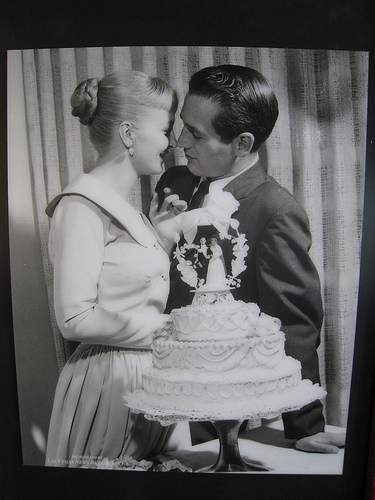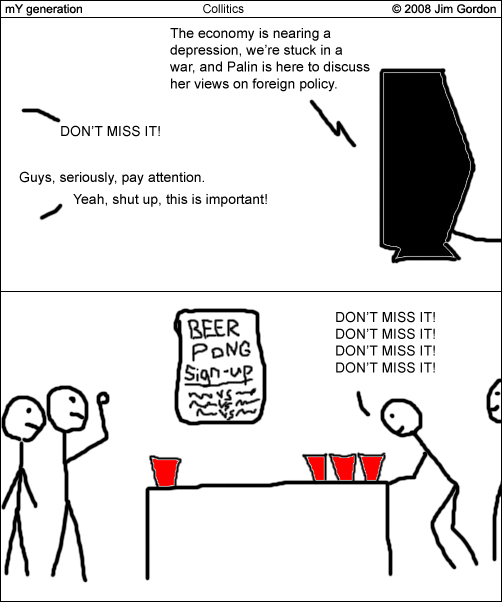|
|
|
Archive for September, 2008
Tuesday, September 30th, 2008
This is part 1 in an ongoing discussion.
 Evolution may be one of the most powerful forces in the world. It is certainly one of the most peculiar natural forces, with the unusual characteristic of being a long-term, natural statistical process with no particular goal. Because it is statistical it is not as dependable as the law of gravity. Because it is statistical, it operates over thousands of trials, so it operates over long time scales – often millions of years. It does not have any particular goal, but it does seem to move in particular directions. Finally, it operates with a very simple set of rules, needing only some life and three actions to work its magic: Evolution may be one of the most powerful forces in the world. It is certainly one of the most peculiar natural forces, with the unusual characteristic of being a long-term, natural statistical process with no particular goal. Because it is statistical it is not as dependable as the law of gravity. Because it is statistical, it operates over thousands of trials, so it operates over long time scales – often millions of years. It does not have any particular goal, but it does seem to move in particular directions. Finally, it operates with a very simple set of rules, needing only some life and three actions to work its magic:
- Replication (Reproduction)
- Variation (Mutation)
- Selection (Survival)
Evolution starts the survivors of the last generation and uses them to produce the next generation. Replication is very good, but not perfect, so a few variations creep in. This new generation, with its variations, competes in the environment. The survivors then seed the next generation. While this process appears almost trivial, over millions of generations (or statistical trials) the random process of evolution has created some amazing forms of life, including people who are reading and writing this blog.
If evolution is so powerful, can we use its basic principles to drive improvements in a business? Yes, but the deeper question is how. Before digging into that question, let’s investigate three environmental conditions required for evolution to operate.
- Evolution requires many trials in each generation, because it is a random process. Fail often.
- Evolution operates only over a large number of generations. Fail fast.
- The external selection criteria (the measure of fitness) must be stable over many generations.
In short, evolution won’t work in any environment that does not provide these three conditions. Some operations within a business might provide these conditions, while other business operations might not.
Celebrate Failure—Fail fast, fail often.
In the late nineties (in the last century), many business books and business consultants preached about “celebrating failure.” One popular expert took the concept even further, exhorting his readers to “fail fast, and fail often.” Little did he know he was advocating an evolutionary approach to business. While it makes no sense to celebrate failure per se, it does make sense to celebrate failures which identify dead-end paths. The quicker a company can explore and eliminate opportunities, the quicker it will find good opportunities to exploit. A business seeks successful markets, successful products and successful customers. In the search for these successes a business will encounter many dead-ends, or failures. Failing fast and failing often will accelerate the discovery of the successful markets and products. In evolutionary terms, the business will discover survivable niches in its environment only as rapidly as it explores its business environment. Therefore, don’t celebrate failure, but work hard to fail fast and often.
Evolution has a high failure rate at every level. Within a single generation, very few of the members survive to propagate. Of all the acorns an oak tree grows, almost none actually grow to be another oak. Most don’t even survive to become a sprout. Within each single generation, evolution fulfills the exhortation to “fail often.”
Evolution also prefers to “fail fast.” In the mammal kingdom, evolution starts a new generation every year for large animals, even if an individual mammal may survive many years. But evolution is not locked into the annual calendar. At the bacteria level, evolution can starts a new generation every few hours or so. In a business what are the natural generation time cycles for various operations? How can a business accelerate its generational cycles to “fail faster?”
Selection Criteria – External, not Internal
Evolution simply provides the experiments, by creating variations. The environment provides the selection criteria that pick the winners. Each species “discovers” these environmental selection criteria by watching which the variations survive. Each of these variations contributes a small amount of improved survivability to the species. It is critical to understand that the selection criteria are not provided internally, by a president, business owner, or central planner. The business must discover the natural selection criteria in its environment—its customers, competitors, suppliers, and partners. This is particularly difficult for most businesses because, as business leaders and owners, we think we should “lead” the business.
In addition to being hidden in the environment, selection criteria also change over time, usually slowly, but sometimes suddenly. Dinosaurs thrived largely unchanged for hundreds of millions of years. Over that time the environment changed little, so the selection criteria for survival changed very little. Dinosaurs, already pretty good at surviving in a hot, humid environment, continued to thrive while evolution made only small changes at the margins. However, a sudden cataclysm (huge meteor, giant sunspot, massive volcanic eruption or something else?) changed the environment almost instantly. Hot and humid switched to cool and dry. Swamps dried up, plants changed and selection criteria for survival changed accordingly, faster than dinosaurs could adjust. A previously marginal species—prototype mammals—had the unusual ability to regulate its body temperature internally. While dinosaurs could not stay warm in the new environment, the prototype mammals thrived.
Several million years later, we are reading and writing business blogs. In this environment of constant change, the selection criteria for survival in business change swiftly, sometimes overnight.
Business leaders and owners have great difficulty in discovering the selection criteria for business survival. Even worse, when a business leader finally does “get it right,” the criteria for business survival change, leaving the business leaders leading furiously in the wrong direction.
So, what do we do? The good news is that business leaders are not evolving into extinction. But, the requirements for business success are evolving, swiftly.
Are you leading your company into extinction?
Tune in next week as we explore in depth how a business can evolve toward success.
Posted in Business info, Culture, Innovation, Leadership | 1 Comment »
Tuesday, September 30th, 2008
 It’s a sad commentary on the business world, but thousands of times a day, day after day, bosses in every industry, in companies large and small, issue “or else” ultimatums to their subordinates—whether intentionally or not—and ultimatums are threats. The threats are rarely direct (Do it or start looking.), more often, they are subtle (I expect employees who work here to be team players.), but the threat is there: Do X if you want to keep your job. It’s a sad commentary on the business world, but thousands of times a day, day after day, bosses in every industry, in companies large and small, issue “or else” ultimatums to their subordinates—whether intentionally or not—and ultimatums are threats. The threats are rarely direct (Do it or start looking.), more often, they are subtle (I expect employees who work here to be team players.), but the threat is there: Do X if you want to keep your job.
Obviously, this is atrocious management, since
- threats are tremendously debilitating to those receiving them, often costing them the confidence to do their job; but
- it is the manger who threatens who loses the most—the credibility to run the organization.
Beyond the direct effect of the threats, there is a ripple effect that is far worse—the seeding of a self-propagating culture of intimidation, i.e., I’ll do it to you because the person above does it to me [and I want to get even].
It kills creativity, innovation, motivation, engagement, caring, ownership, in fact, everything that it takes to compete in today’s economy.
The good news is that, as with most management practices, the choice of using or not using ultimatums, no matter the form, is yours, and yours alone.
Your comments—priceless
Don’t miss a post, subscribe via RSS or EMAIL
Image credit: CraigPJ CC license
Posted in About Leadership, Communication, management | 8 Comments »
Monday, September 29th, 2008
Last year I wrote about the pros and cons of AMS (assumption, manipulation and self-fulfilling prophesy). As I said then, although there are positive aspects AMS usually surfaces in a negative way.A client who agrees with how important it is to avoid AMS asked me to come up with a simple, memorable way to present why assuming isn’t a good thing to do. He wanted something that would really sink in, not in a preachy way, but a fun way to which all his people could relate in all parts of their lives.
So I was staring at the word on the screen and that’s when I realized that we could use an oldie to put the idea across in just 13 words.
Now, scattered around the offices are signs that read
Think before you assume—don’t make an ass out of u and me!

Your comments—priceless
Don’t miss a post, subscribe via RSS or EMAIL
Image credit: claumart CC license
Posted in Communication, Culture, Group Dynamics, management, Personal Development | No Comments »
Monday, September 29th, 2008
Image credit: rore_d CC license
 A recent IBM ad says, “Stop selling what you have and start welling what they need.” A recent IBM ad says, “Stop selling what you have and start welling what they need.”
Even if you can’t change your product line you can still sell what they need by listening to what they say.
Steve Roesler has a great example of how to lose a sale; as Steve points out, “Language can communicate or obfuscate.”
The problem is that salespeople may be slow to change their approach if it’s been working, but dumping them because a candidate shows up who tells a better story is rarely a good solution. In most cases you’re better off to invest time and effort in the person who knows your products and markets.
But you need to invest differently when MAP (mindset, attitude, philosophy™) is involved.
In Steve’s example it’s far more than language that cost the losing vendor the sale—it was the guy’s MAP that did him in.
Talking TO a customer is as bad as talking AT one. The only TO should apply to listening—when it comes to talking the apropos word is WITH.
Arrogance doesn’t play well in any market and the tighter the market the less it plays.
MAP change is much more than responsive language or better listening skills. MAP can be changed, but the need for that change must be acknowledged, desired and done by the person because she wants to change, not because the boss suggested it or the sales training recommends it.
MAP change is internal and has much in common with the horse and the water.
So when you’re evaluating your sales people’s performance be sure to differentiate between approach and MAP and then act accordingly.
Posted in Business info | No Comments »
Sunday, September 28th, 2008
It’s a sad Saturday night as I write this. I don’t watch the news so I wasn’t aware that Paul Newman died Friday. I grew up watching his movies and reading about his life beyond them. Newman was a great actor and director, but he was a brilliant human being—a much more important role, although you wouldn’t know it in today’s celebrity-hyped world. I grew up watching his movies and reading about his life beyond them. Newman was a great actor and director, but he was a brilliant human being—a much more important role, although you wouldn’t know it in today’s celebrity-hyped world.
His amazing 50 year marriage to Joanne Woodward is proof that marriage is dependent on the people involved, not outside circumstances.
But it was his political stands and philanthropic efforts that always resonated most with me.
Newman’s Own donates all profits and has given away more than $200 million. He founded Newman’s Hole in the Wall camps with 11 around the world—135,000 gravely ill children have attended them free of charge.
And now, a few words from Paul…
“Why would I go out for a hamburger when [I] have steak at home?” (In reference to why he never strayed.)
“Who’s to say who’s an expert?” (Certainly somehting to keep in mind the next time you get ‘expert’ advice.)
“The embarrassing thing is that the salad dressing is outgrossing my films.” (Happily so. He couldn’t donate the film profits.)
“I picture my epitaph: “Here lies Paul Newman, who died a failure because his eyes turned brown”. (Failure never even came close.)
“If you don’t have enemies, you don’t have character.” (Newman proved this one totally wrong.)
“You can’t be as old as I am without waking up with a surprised look on your face every morning: ‘Holy Christ, whaddya know – I’m still around!’ It’s absolutely amazing that I survived all the booze and smoking and the cars and the career.” (But not for nearly long enough.)
Goodbye, Paul, you will be sorely missed!
Your comments—priceless
Don’t miss a post, subscribe via RSS or EMAIL
Image credit: danperry.com CC license
Posted in Leaders Who DO, Quotable Quotes, Strength & Grace | No Comments »
Sunday, September 28th, 2008
We interrupt the production of George II to bring you an urgent message from the author regarding the happenings of the past week—which were followed with rapt attention by him and his roomies. See all mY generation posts here.

Posted in mY generation, Politics | No Comments »
Saturday, September 27th, 2008
Have you stopped to think that the “leaders” responsible for this mess are mostly Boomers and a few older Gen X?
It doesn’t surprise me, the Boomers’ parents tried to give them everything that they didn’t have and ended up with the first sex/drugs/rock&roll generation that thumbed their collective nose at “the rules” more than any previous one.
They, in turn, raised the first “entitled” generation and Gen X has increased that attitude by an order of magnitude.
In 1977 Richard Nixon said, “When the president does it, that means it is not illegal,” and it seems as if the generations that revile him have taken that as their individual mantra—in spirit if not in fact.
The effort eliminate accountability and further increasing that sense of entitlement to further trash future leaders’ ethical base is in full swing. (Texas seems to be taking a leading role in both. Read this, this and this.)
Religion doesn’t seem to be the answer—I’m sure that most “leaders” of the current debacle would tell you that they have a strong faith, as would all the religious “leaders” who have lied, cheated, stolen and abused.
Education certainly doesn’t lead to a higher moral plane—the millions of people damaged by the well-educated people who wreaked havoc on the global economy certainly equals, if not exceeds, the damage done by drug dealers and other criminals.
Obviously, ignorance doesn’t cut it, either.
I don’t know the answer, but I’m pretty sure it starts in the crib and the initial responsibility belongs to the people responsible for creating that life.
Your comments—priceless
Don’t miss a post, subscribe via RSS or EMAIL
Photo by Sandy Caldwell
Posted in About Leadership, Ethics, Personal Development, Politics | 1 Comment »
Saturday, September 27th, 2008
Image credit: davidlat CC license
This is a guest post by Korn/Ferry International’s Kevin Cashman and Ken Brousseau (detailed bios at end of post.), in which they apply their CEO assessment, expertise and constructs to the Presidential candidates.
Note: The candidates are discussed in random order and reflects no preference by the authors.

Voters commonly cast their ballots based on the critical issues and policies, but what about the equally crucial assessment of a candidate’s leadership strengths and approaches?
- Who is the leader beneath the speeches, policies and ads?
- How would experts describe the unique leadership styles of Barrack Obama and John McCain if they were being assessed for a global CEO position?
Two leadership authorities from one of the world’s largest talent management firms, Korn/Ferry International, point to four critical and differentiating facets of Obama and McCain’s leadership:
- decision-making styles;
- emotional temperaments;
- learning agility; and
- power-of-voice versus power-of-connection.
Overall, Cashman and Brousseau say that
- McCain’s strengths appear to be action-orientation, adherence to principle and a fiery tenacity to achieving results, whereas
- Obama tends to demonstrate exceptional learning agility, collaboration and is calmer under pressure.
1. Decision-Making Styles – Cashman and Brousseau assert that both candidates are principled decision-makers, but differ in their propensities to quickly or analytically make decisions and hone in on single versus multiple courses of action. Korn/Ferry’s research (see this Harvard Business Review article) at shows that those unable to lead in a “complex style” have low likelihoods of succeeding in their positions, yet once they’ve risen to a top level, it’s possible to succeed with multiple approaches. They observe:
- McCain is a more uni-focused thinker who focuses on one key principle or goal and tenaciously holds to a particular action rather than changing positions. When not in action-mode, he shifts to a more complex style that’s both analytic and uni-focused, efficiently studying the facts, and making and sticking to what he senses is the best decision.
- Obama also operates in the complex mode, but more often uses a creative and integrative style that is analytic and more open to alternate possibilities. Before making a judgment, he studies an extensive array of information and options, then gradually forms a strategy combining multiple objectives, actions and viewpoints.
2. Emotional Temperaments – The ability to manage the emotions of one’s self and those around them is a defining aspect of leadership at any level.
- When principles are challenged or threatened, McCain seems to be more emotive and combative to win the day. Achieving high performance works best for him in a high-octane pace where things are very active.
- Obama tends to maintain equanimity and gets introspective to sort out the best solutions to win, asking his staff to provide him with some reflective time each day. His high performance is achieved by reflecting, synthesizing and collaborating.
3. Leadership Agility and Ability to Deal with Ambiguity -The key leadership competency in shortest supply is the ability to deal with ambiguity, according to the research of Korn/Ferry and others and supported by past Presidents who’ve described the job as “everything happening all at once.” Though we often dub political leaders who change their positions as wishy-washy, Cashman and Brousseau say that can be a sign of agility, as good leaders summon past lessons and observations to reframe thinking in first-time contexts or changing global environments. Agility – found to be much more predictive of potential and success than raw intelligence – has components related to mental, people, results and change.
- Obama demonstrates exceptional mental agility and has proclivity for dealing with change and people, but critics may question if his results agility on a large-scale have been sufficiently demonstrated.
- McCain, in contrast, shows a strong results orientation and a measure of mental agility, but his history of working amid volatility and commitment to tradition may call his agility with people and change into question.
4. Exerting Power-of-Voice or Power-of-Connection – Cashman and Brousseau say that many leaders can be understood as either heroic leaders who assert their power-of-voice or more interpersonally inclined leaders who employ power-of-connection. The key is being able to exercise the weaker, non-default area. According to research by Zenger and Folkman, leaders who excel in people or results only, reach the 90th percentile of leadership effectiveness nine or 13 percent of the time, but those who possess both reach that level of success in two-thirds of instances.
- McCain, as someone who forcefully asserts for results, best typifies the heroic “I” type of leader, who leverages personal influence to impact results. The downside can be too much drive and not enough relational connection.
- Obama and his collaborative approach characterize “We” leaders, who leverage collaboration, relationship and synergy to get results. In crisis situations, however, sometimes more “I” is required.
The leadership experts say Obama fits the overall archetype of a “magician” leader, someone who blends ideas and people to produce new solutions to unsolved problems.
McCain, on the other hand, is more of the traditional “warrior” leader, bringing about results through force of will or assertion with little fear of adversarial relationships or situations.
About the authors:
Kevin Cashman, author of the newly expanded book Leadership from the Inside Out , founded LeaderSource, a Minneapolis-based international leadership development, executive coaching and team effectiveness consultancy that joined with Korn/Ferry International in 2006. Leadership from the Inside Out, available in second edition in September, was named the #1 best-selling business book of 2000 by CEO-READ and one of the top 20 best-selling business books of the decade. Over the past 25+ years, Cashman and his team have coached thousands of senior executives and teams to enhance performance. , founded LeaderSource, a Minneapolis-based international leadership development, executive coaching and team effectiveness consultancy that joined with Korn/Ferry International in 2006. Leadership from the Inside Out, available in second edition in September, was named the #1 best-selling business book of 2000 by CEO-READ and one of the top 20 best-selling business books of the decade. Over the past 25+ years, Cashman and his team have coached thousands of senior executives and teams to enhance performance.
Kenneth Brousseau, Ph.D., is CEO and co-founder of Decision Dynamics LLC, a firm specializing in behavior profiling and human resource systems design. Prior to forming Decision Dynamics, he served as a management and organization professor at the University of Southern California Graduate School of Business Administration. Dr. Brousseau specializes in behavioral assessment systems for purposes of employee selection, organizational development and career management. He is coauthor of The Dynamic Decision Maker, and he has authored articles on career development, work system design, team development and organizational design in publications such as Harvard Business Review, the Journal of Applied Psychology and the Academy of Management Executive.
Posted in Leadership, Politics | 1 Comment »
Friday, September 26th, 2008
Image credit: Andreius CC license
A manager sent the following to me and asked if I agreed. I’ve seen it before and I’m sure that many of you have, too.
What Makes 100%? What does it mean to give MORE than 100%? Ever wonder about those people who say they are giving more than 100%? We have all been to those meetings where someone wants you to give over 100%. How about achieving 103%? What makes up 100% in life?
By equating numbers to letters you can answer these questions:
A b c d e f g h I j k l m n o p q r s t u v w x y z
1 2 3 4 5 6 7 8 9 10 11 12 13 14 15 16 17 18 19 20 21 22 23 24 25 26
Therefore
Hard work (8+1+18+4+23+15+18+11) = 98%
and
Knowledge (11+14+15+23+12+5+4+7+5) = 96%
but,
Attitude (1+20+20+9+20+21+4+5) = 100%.
However,
Bullshit (2+21+12+12+19+8+9+20) = 103%
and
Ass kissing (1+19+19+11+9+19+19+9+14+7) = 118%
So, one can conclude with mathematical certainty, that while Hard Work and Knowledge will get you close, and Attitude will get you there, it’s the bullshit and ass kissing that will put you over the top.
But what happens if you drop the cynicism and take a close look at the one trait that will truly put you head and shoulders above the rest.
Extraordinary effort (5+24+20+18+1+15+18+4+9+14+1+18+25+5+6+ 6+15+18+20) = 242%
Combine that with attitude and you’ll be an unstoppable 342%er and the person everyone wants on their team.
Posted in Business info, Just For Fun, Personal Growth | No Comments »
Friday, September 26th, 2008
 I’ve never been a big believer in the cult of individual leadership, a subject brilliantly discussed at Managing Leadership.The current economic meltdown is brought to you by the same folks who have been lauded for years for their extraordinary leadership. I’ve never been a big believer in the cult of individual leadership, a subject brilliantly discussed at Managing Leadership.The current economic meltdown is brought to you by the same folks who have been lauded for years for their extraordinary leadership.
Nor do I believe that leadership is positional; true leadership is found at all levels—it comes forward and makes itself felt when need arises.
Of course, that rarely happens, since most organizations subscribe to the tenets of individual and positional leadership.
CEOs are praised for their brilliant leadership during good times and condemned for not producing the same results in economic downturns.
Worse, their results are compared to predecessor’s performance during heady economic expansion—an environment in which it takes far less skill to produce profits.
It’s said that leadership requires vision and all these leaders had visions—unfortunately. They had visions of being the biggest, baddest, richest corporation in their field—and they were lauded for that vision.
It will be interesting to watch leadership gurus roll out the disclaimers and disavow the same folks who they’ve held up as examples of how to lead.
Your comments—priceless
Don’t miss a post, subscribe via RSS or EMAIL
Image credit: izzyplante CC license
Posted in About Leadership, Ethics, Leaders Who DON'T | No Comments »
|
 Subscribe to
Subscribe to
MAPping Company Success
About Miki 
Clarify your exec summary, website, etc.
Have a quick question or just want to chat? Feel free to write or call me at 360.335.8054
The 12 Ingredients of a Fillable Req
CheatSheet for InterviewERS
CheatSheet for InterviewEEs™
Give your mind a rest. Here are 4 quick ways to get rid of kinks, break a logjam or juice your creativity!
Creative mousing
Bubblewrap!
Animal innovation
Brain teaser
The latest disaster is here at home; donate to the East Coast recovery efforts now!
Text REDCROSS to 90999 to make a $10 donation or call 00.733.2767. $10 really really does make a difference and you'll never miss it.
And always donate what you can whenever you can
The following accept cash and in-kind donations: Doctors Without Borders, UNICEF, Red Cross, World Food Program, Save the Children
*/
?>About Miki
About KG
Clarify your exec summary, website, marketing collateral, etc.
Have a question or just want to chat @ no cost? Feel free to write
Download useful assistance now.
Entrepreneurs face difficulties that are hard for most people to imagine, let alone understand. You can find anonymous help and connections that do understand at 7 cups of tea.
Crises never end.
$10 really does make a difference and you’ll never miss it,
while $10 a month has exponential power.
Always donate what you can whenever you can.
The following accept cash and in-kind donations:
|
 Evolution may be one of the most powerful forces in the world. It is certainly one of the most peculiar natural forces, with the unusual characteristic of being a long-term, natural statistical process with no particular goal. Because it is statistical it is not as dependable as the law of gravity. Because it is statistical, it operates over thousands of trials, so it operates over long time scales – often millions of years. It does not have any particular goal, but it does seem to move in particular directions. Finally, it operates with a very simple set of rules, needing only some life and three actions to work its magic:
Evolution may be one of the most powerful forces in the world. It is certainly one of the most peculiar natural forces, with the unusual characteristic of being a long-term, natural statistical process with no particular goal. Because it is statistical it is not as dependable as the law of gravity. Because it is statistical, it operates over thousands of trials, so it operates over long time scales – often millions of years. It does not have any particular goal, but it does seem to move in particular directions. Finally, it operates with a very simple set of rules, needing only some life and three actions to work its magic:



 It’s a sad commentary on the business world, but thousands of times a day, day after day, bosses in every industry, in companies large and small, issue “or else” ultimatums to their subordinates—whether intentionally or not—and ultimatums are threats. The threats are rarely direct (Do it or start looking.), more often, they are subtle (I expect employees who work here to be team players.), but the threat is there: Do X if you want to keep your job.
It’s a sad commentary on the business world, but thousands of times a day, day after day, bosses in every industry, in companies large and small, issue “or else” ultimatums to their subordinates—whether intentionally or not—and ultimatums are threats. The threats are rarely direct (Do it or start looking.), more often, they are subtle (I expect employees who work here to be team players.), but the threat is there: Do X if you want to keep your job.

 I grew up watching his movies and reading about his life beyond them. Newman was a great actor and director, but he was a brilliant human being—a much more important role, although you wouldn’t know it in today’s celebrity-hyped world.
I grew up watching his movies and reading about his life beyond them. Newman was a great actor and director, but he was a brilliant human being—a much more important role, although you wouldn’t know it in today’s celebrity-hyped world.



 I’ve never been a big believer in the cult of individual leadership, a subject brilliantly discussed at
I’ve never been a big believer in the cult of individual leadership, a subject brilliantly discussed at 
